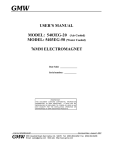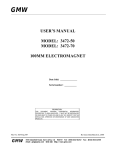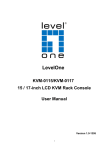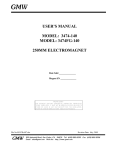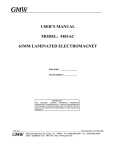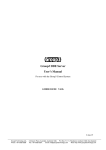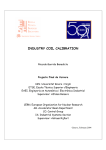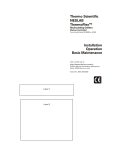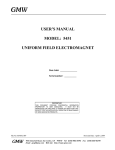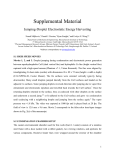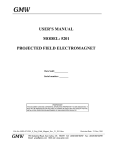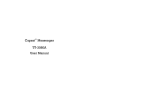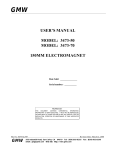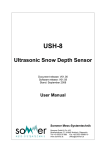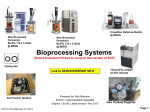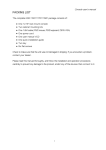Download USER`S MANUAL MODEL: 5501 250MM
Transcript
GMW USER’S MANUAL MODEL: 5501 250MM ELECTROMAGNET Date Sold: ___________ Serial number: _________ PROPRIETARY THIS DOCUMENT CONTAINS CONFIDENTIAL INFORMATION PROPRIETARY TO GMW ASSOCIATES. IT MUST NOT BE REPRODUCED OR DISCLOSED TO OTHERS OR USED IN ANY WAY EXCECPT FOR THE INSTALLATION, OPERATION OR MAINTENANCE OF GMW ASSOCIATES PRODUCTS. File No: M5501c.407 Revision Date: July, 2009 _________________________________________________________________________________ 955 Industrial Road, San Carlos, CA 94070 Tel: (650) 802-8292 Fax: (650) 802-8298 Email: [email protected] Web site: http://www.gmw.com GMW TABLE OF CONTENTS SPECIFICATIONS Table 1 Model 5501 General Specifications Table 2 Model 5501 Electrical and Water Connections Section 1 WARNINGS [ Refer to this section before operation of Electromagnet ] Section 2 INSTALLATION Unpacking Instructions Electrical Circuit Interlocks Cooling Section 3 OPERATION General Calibration Field Control Operation Section 4 MAINTENANCE Section 5 STANDARD OPTIONS Probe Holder Section 6 CUSTOM OPTIONS Section 7 EXCITATION CURVES Section 8 TEST DATA Section 9 DRAWINGS Section 10 Elmwood 3450 Thermostats Johnson Controls 61 Series Flow Switches Drawing 11910000 5501 Electromagnet General Assembly (Specifications and Dimensions Sheet 1) Drawing 11910000 5501 Electromagnet General Assembly (Detailed Drawing and Parts List Sheet 2) Section 1 SPECIFICATIONS Table 1. Model 5501 Specifications ------------------------------------------------------------------------------------------------------------------------Pole Diameter 250mm (10 inch) Pole Gap Coils (series connection) coil resistance (20°C) max resistance (hot)* max power (air) max power (water) Self Inductance Water Cooling (18°C) Overtemperature Interlock Water Flow Interlock Dimensions Weight 204mm (8.0 inch) 0.160 Ohm 0.180 Ohm 60A/10V (0.60kW) 212A/36V (7.63kW) 80mH (measured at 5Hz) 10 liters/m (2.75 US gpm) 0.8 bar (12 psid) Elmwood 3450G thermal sensor part number 3450G 611-1 L50C 89/16 mounted on each coil and wired in series. Contact rating 120Vac,0.5A. Closed below 50oC. Johnson Controls flow switch part number F61KD mounted on outlet side of water circuit. Contact rating 120Vac/16A, 240Vac/8A non inductive Set to open at a flow of less than 8 l/min (2.1 USgpm) Drawing 11910000 828mm W x 558mm D x 754mm H (33.0 inch W x 22.0 Inch D x 30.0 inch H) 1310 kg (2880 lb) *CAUTION - The value of maximum coil resistance given should not be exceeded. At this resistance the coils are at maximum safe temperature for continuous operation. 1-1 Section 1 SPECIFICATIONS Table 2. Model 5501 Electrical and Water Connections DC Current (Refer to Drawing 11910000 Sheet 1) Right hand terminal Negative Left Hand terminal Positive Ground An M6 screw is provided alongside the interlock connections to enable the magnet frame to be grounded according to local safety regulations. It is normally appropriate to connect the magnet frame to the power supply ground. Interlocks (Refer to Drawing 11910000 Sheet 1) 1 Water flow 2 Water flow 3 Overtemperature 4 Overtemperature 5 No connection 6 No connection 7 No connection 8 Control ground Normally open. Closed when flow over 8 l/min (2.1 USgpm) Normally closed. Open when coil temperature exceeds 50oC. Water (Refer to Drawing 11910000 Sheet 1) outlet 3/8 inch NPT inlet 3/8 inch NTP (mating couplings for 1/2 inch hose provided) -------------------------------------------------------------------------------------------------------------------------- CAUTION - Ensure that the high current connections are tight. Loose connections may lead to oxidation and overheating. The field stability may be degraded and the current terminations damaged. 1-2 Section 2 WARNINGS REFER TO WARNINGS BELOW BEFORE OPERATING ELECTROMAGNET 1 Personnel Safety In operation, the magnet fringing field is in excess of 0.5mT (5G). This can cause malfunctioning of heart pacemakers and other medical implants. We recommend that the fringing field should be mapped and warning signs be placed outside the 0.5mT (5G) contour. Entry to this region should be restricted to qualified personnel 2 Ferromagnetic Objects During operation the magnet exerts strong magnetic attraction towards ferromagnetic objects in the near vicinity of its pole gap or coils. Loose objects can be accelerated to sufficient velocity to cause severe personnel injury or damage to the coils or precision pole faces if struck. Keep ferromagnetic tools clear! 3 Arcing This magnet stores considerable energy in its field during operation. Do not disconnect any current lead while under load or the magnetic field energy will be discharged across the interruption causing hazardous arcing. 4 Coil Hot Resistance Do not exceed the maximum coil hot resistance given in the specifications or coil overheating and possible damage may occur. 5 Interlocks These should always be connected if the magnet is operated unattended, to avoid the possibility of coil overheating caused by excessive power dissipation or inadequate cooling. 6 Watches, Credit Cards, and Magnetic Disks Do not move magnetically sensitive items into the close vicinity of the magnet. Even some antimagnetic watches can be damaged when placed in close proximity to the pole gap during operation. Credit cards, and magnetic disks are affected by magnetic fields as low as 0.5mT (5G). Depending on the previous operating field and the pole gap, the remanent field in the gap can be in excess of 50G (5mT) with the magnet power supply off or disconnected. 2-1 Section 3 INSTALLATION Caution: This is a heavy system. The magnet mass is approximately 1310 kg (2880 lb) so lifting equipment of this capacity should be used to shift the magnet. Two lifting brackets are provided. Flexible lifting slings of at least 4000kg (9,000 lb) lifting capacity are recommended to avoid damage to the magnet. All movement, lifting and installation of the 5501 Electromagnet must be under the supervision of an experienced person to prevent the possibility of serious injury or damage to the Electromagnet and associated equipment. Unpacking Instructions and Damage Inspection To unpack the electromagnet please use the following procedure. 1. First remove all of the "Hex Head Screws" located at the lower edge of all the side panels of the "Crate Top Cover". 2. Gently rock the "Crate Top Cover" to work it loose from the shipping crate base. 3. Use one person on each side of the shipping crate grip the side panels of the Crate Top Cover. Lift "Crate Top Cover" high enough to clear top of electromagnet, walk cover sideways to clear area and place on floor. 4. Inspect the magnet to ensure that no damage has occurred to the magnet in shipment. If damage is evident report the damage in detail to the shipper for claim and simultaneously notify GMW in case assessment of the damage must be made. If no damage is found proceed with magnet unpacking and installation. 5. Remove the M16 Hex Bolts that secure the magnet to the steel shipping angle brackets. 6. Remove the hex lag bolts that secure the steel "shipping angle brackets" to shipping crate base, and remove shipping angle brackets. 8. The magnet is now prepared for final installation. Direct Mounting 1. With suitable lifting equipment (e.g. 4000kg (9000 lb.) minimum safe lifting rating), lift magnet 50mm (2") clear of shipping crate base. 2. Slide shipping crate base clear. 3. Lower magnet to 50mm (2") above floor. 4. Move magnet to final location and secure using the steel shipping angle brackets. The brackets can be modified to suit installation space needs. 3-1 Section 3 INSTALLATION Electrical Circuit (Refer to drawing 11910000 Sheet 1). Never connect or remove cables from the magnet with the power supply connected. The stored energy in the magnet can cause arcing resulting in severe injury or equipment damage. The magnet has two coils which are connected in series. The power supply cables should be connected directly to the DC current terminals marked + and -. Recommended current cable is stranded copper of 85mm² cross section (3/0 AWG) standard copper current cables. Because the magnet stores a significant amount of energy in its magnetic field, special care should be taken to insure that the current terminations are secure and cannot work loose in operation. Local heating at the terminations can cause rapid oxidation leading to a high contact resistance and high power dissipation at the terminals. If left unattended this can cause enough local heating to damage the terminals and the coils. Interlocks Six thermal sensors Elmwood 3450G Part Number 3450G611-1 L50C 89/16 are wired in series and terminated in positions 3 and 4 on the Interlock Terminal block. They are normally closed, opening when the coil central cooling plate temperature exceeds 50oC +/3oC. The flow switch is connected to terminals 1 and 2. The contacts are normally open, closing when the water flow exceeds approx. 10 l/min. Cooling The Model 5501 can be operated to an average coil temperature of 70oC. Assuming an ambient laboratory temperature of 20oC and a temperature coefficient of resistivity of 0.00393, the hot resistance of the coil should not exceed 20% more than the ambient temperature "cold" resistance. The coil thermal sensor will open when the coil cooling plate temperature exceeds approximately 50oC Clean, cool (12oC - 20oC) water at 15 l/min and 2.0 bar (30 psid) should be used to cool the magnet. The cooling tubes are not electrically connected to the coils so no electrochemical corrosion will occur. If the water supply contains particulates, a 50 micron filter should be placed before the input to the magnet to avoid unreliable operation of the flow switch. For continuous operation of the magnet it may be appropriate to use a recirculating chiller to reduce water and drainage costs. The chiller capacity will depend on whether cooling is required for the magnet alone or magnet and power supply. For the Model 5501 Electromagnet alone a suitable chiller is the Neslab HX-300 with PD-2 pump. Use distilled or deionized water with a biocide to prevent bacterial growth and corrosion. Do not use corrosion inhibitors in high quality electrical systems since the water conductivity is increased which can result in increased leakage currents and electrochemical corrosion. 3-2 Section 3 INSTALLATION Cooling (continued) At currents of below 60A for coils that are series connected or 80A for series/parallel connected coils the Model 5501 can be operated safely without water cooling. However the coil temperature will vary with the power dissipation. This results in dimensional and permeability changes of the magnet yoke. Air cooling is not suitable when high field stability is required. Freon, oil, ethylene glycol or other cooling mediums can be used. The flow required will be approximately inversely proportional to their specific heats. An experimental determination of the flow and pressure required will be necessary. Avoid cooling the magnet below the dew point of the ambient air. Condensation may cause electrical shorts and corrosion. During operation the resistance can be checked using a voltmeter across each coil. The voltage will rise to a constant value once thermal equilibrium has been reached. If it is desired to save water, the flow can be reduced until the hot resistance is approached. NOTE: This adjustment must be made slowly enough to allow for the thermal inertia of the coils. 3-3 Section 4 OPERATION General The magnet operates as a conventional electromagnet. 1. Adjust the cooling water flow to about 10 liters/min (2.75 US gpm). For operation at less than maximum power the water flow may be correspondingly reduced. 2. Turn on the power supply and increase the current until the desired field is reached. Calibration The induction curves may be used to estimate the field in the air gap to within four or five percent. More accurate field determination may be obtained by deriving experimentally a calibration curve for the particular pole and air gap combination being used. Magnetic hysteresis in the yoke and poles can cause an error of 30 to 70G (3 to 7mT) with an arbitrary application of such a calibration curve. This effect may be reduced to less than one percent by following a prescribed 'current setting schedule' designed to make the magnet 'forget' its prior magnetic history. The schedule should of course be used both in establishing the calibration curve and in its subsequent use. A possible schedule would be: From zero current, increase to maximum current and reduce again to zero current. Increase again to maximum current and reduce to the current to give the desired field setting. Approaching the desired field from a higher setting will typically produce better field uniformity. This is because the field changes at the pole edges will normally lag the field change at the center thereby helping to compensate the radial decrease in field. Greater precision in setting up the calibration curve will be achieved with the use of a digital gaussmeter and by making a numerical table. This table used with an interpolation routine will eliminate the error associated with reading a graph. In any event, three points need to be remembered: 1. A calibration curve or table is only as good as the precision employed in generating it. 2. The field is defined only at the point it is measured. It will generally be different at a different point in the air gap. For example, the induction curves refer to the field on the pole axis and at the center of the air gap (median plane). 3. The field is most directly a function of the current in the magnet coils. Voltage across the coils is not a good measure of field since the electrical resistance of the coils depends on the temperature (about 0.4% per degree Celsius). Field Control Operation The necessity to use calibration curves can be avoided by using a field controller to sense the magnetic field and provide a corresponding power supply control signal through the power supply programming inputs. Contact GMW for suitable instrumentation. 4-1 Section 5 MAINTENANCE Periodically check that the pole adjustment mechanism is clean, properly lubricated and free of grit and dirt which may cause binding of the mechanism. Otherwise no particular maintenance is required. Be very careful not to damage the relatively soft pole surface since this may degrade the magnetic field uniformity in the gap. Note that surface treatments used provide good corrosion protection but in order to maintain the inherent mechanical precision of the magnet, heavy build-up of plating materials is deliberately avoided. As a result, high humidity or otherwise seriously corrosive atmospheres can defeat the protection mechanisms. Check the equipment periodically and use an appropriate corrosion protection when the magnet is stored for an extended period. 5-1 Section 6 STANDARD OPTIONS Section 7 CUSTOM OPTIONS Section 8 EXCITATION CURVES GMW Associates Electromagnet Excitation Plot Field Vs Current Contract No: Customer: Page: 1 of 1 Model: Serial No: 5501 01 Power Supply: Serial No: Pole Face: Serial No: Pole Gap: Pole Spacers: 250 mm None 204 None Position: Notes: Date: Engr: Feb 23, 2000 G.Douglas Set Current: Target Field: X=0, Y=0, Z=0 1.0 0.9 0.8 0.7 Field in Tesla 0.6 Gap mm 204 0.5 0.4 0.3 0.2 0.1 0.0 0 20 40 60 80 100 120 140 Current in Amps Filename: 5501 Sn 01 Ex 250-204 160 180 200 220 240 260 Section 9 TEST DATA GMW Associates Electromagnet Uniformity Plot Field Vs Position Contract No: Customer: Page: Fixed Axis: Model: Serial No: 5501 01 Power Supply: Serial No: Pole Face: Serial No: Pole Gap: Pole Spacers: Dev Spec: 250 None 204 None Teslameter: Serial No: Notes: 3 of 4 Y=0, Z=0 Date: Engr: Waker 280V-280A Nov 28, 1993 H.Glavish Set Current: 212 Amps Target Field: Probe: Serial No: 50,000 45,000 40,000 35,000 30,000 25,000 20,000 Field Deviation in ppm 15,000 10,000 5,000 0 -5,000 -10,000 -15,000 -20,000 -25,000 -30,000 -35,000 -40,000 -45,000 -50,000 -52 -32 -12 08 Position X mm Filename: 5501 Sn 01 Un1 212A XY 250-204 28 48 GMW Associates Electromagnet Uniformity Plot Field Vs Position Contract No: Customer: Page: Fixed Axis: Model: Serial No: 5501 01 Power Supply: Serial No: Pole Face: Serial No: Pole Gap: Pole Spacers: Dev Spec: 250 None 204 None Teslameter: Serial No: Notes: 4 of 4 X=0, Y=0 Date: Engr: Waker 280V-280A Nov 28, 1993 H.Glavish Set Current: 212 Amps Target Field: Probe: Serial No: 50,000 45,000 40,000 35,000 30,000 25,000 20,000 Field Deviation in ppm 15,000 10,000 5,000 0 -5,000 -10,000 -15,000 -20,000 -25,000 -30,000 -35,000 -40,000 -45,000 -50,000 -52 -42 -32 -22 -12 -2 Position Z mm Filename: 5501 Sn 01 Un1 212A XY 250-204 8 18 28 38 48 Section 10 DRAWINGS
































